The Finished Basket
The finished basket from several angles.
For more information on Cherokee Basket Weaving or Cherokee Arts visit Cherokee Artists Association web site.
Step by Step instructions for weaving a Cherokee Double Woven Basket including actual photos of the weaving.
The finished basket from several angles.
For more information on Cherokee Basket Weaving or Cherokee Arts visit Cherokee Artists Association web site.
Posted by
Cherokee Baskets
at
6:51 PM
![]()

This is the finished top, sitting on the bottom. Kind of an interesting view, you can't tell where the top ends and the bottom begins.
Posted by
Cherokee Baskets
at
6:48 PM
![]()
You now should have the following cut spokes:
I sometimes cut a few extra of each color since you never know when you may have a damaged or split spoke when you weave the bottom. Each of my spokes are 50 inches in length.
Now you are ready to weave the bottom. You will need your spray bottle, tape measure, spoke weight and the graph posted earlier in these instructions.
Posted by
Cherokee Baskets
at
9:08 AM
![]()
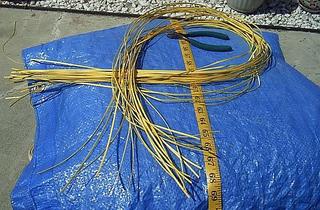
I wet the cane coil again for easier handling, then you pull one strand of cane at a time from the coil. You then measure whatever length you want the cane to be and cut it. I then use the cut piece as the gage for the cutting of the rest of the spokes.
I am using a spoke length of 50 inches, only because I'm going to make a taller basket. Depending on the size of the basket you want you will cut the cane spokes to that length. With this size of cane, you could also cut the spokes 40" in length.
The wider the cane the longer your spokes will need to be as well.
Needed spokes:
1. 36 natural cane spokes
2. 12 yellow spokes
3. 12 walnut spokes (black or dark brown)
4. 12 blood root (orange-red) spokes
Then you need to store the rest of your cane coils dyed and natural in a cool dry place to prevent molding or mildew of the cane.
The woven bottom will determine the size of the basket depending on how many spokes you use in the bottom and the spoke lengths will determine how high the walls of the basket can be.
Posted by
Cherokee Baskets
at
8:48 AM
![]()

This is what the Hamburg (bleached) cane looks like after drying. These will be the three colors I'll use in this basket. I'm going to use all three colors because I think it will make the basket weave more pronounced, so you will see how the weaving looks as you weave through the basket.
The next step in weaving the basket is cutting the cane into the desired length. You will need your reed cutter or scissors and the tape measure for this next step.
Posted by
Cherokee Baskets
at
8:45 AM
![]()

The lighting in my kitchen isn't very good and the flash didn't seem to think it was dark enough to go off...but this is after putting the cane coil in the dye and I usually turn it a few times to make sure it is dyed evenly as well as making sure there are no areas so tight the dye doesn't reach it. This is the yellow dye. I also did a red-orange and a walnut. The walnut is dark because I added too much black in it.
I have them now outside drying til tomorrow and will cut the cane into desired lengths for weaving.
A word of caution when working with both the reed coils and cane coils. They tangle very easily and will become a tangled ball of cane. I have found that by wetting the cane before cutting the ties, that the cane is easier to handle. After wetting, I cut the ties and put it directly into the dye.
I usually die a hank of each color, however, once we get into the weaving you will see exactly how much cane to use. So in some cases, you may want to cut the cane first and then dye the number of spokes you need for each color. I weave a lot, so I usually use all my cane anyway, however, if you say want to try different colors or dye brands, then coloring just the number of spokes you'll use will work as well.
When you dye small amounts of cane, a 1 lb zip lock freezer bag will work as well. That's the zip locks with the zipper type closing not just the pinch type closing. When you use small amounts of cane in the beginning, you can then experiment with brands and colors.
For the Jacquard, I'd say 1/2 or 1/4 batch of dye would work for small numbers of spokes. If you're trying different brands of dye, they usually include instructions on how to use them.
Posted by
Cherokee Baskets
at
8:42 AM
![]()

These instructions are for the Hamburg Cane, the natural cane will not take color because of the hard exterior shell.
I have recently been using Jacquard dyes - they are expensive but give you some very brilliant colors. The dye process with these is also very simple. Also there are other reed dyes on the market that can be used that are less expensive and some people use Rit dye as well. The Jacquard dyes are intense and take almost immediately.
The Jacquard dye colors I use are:
Actually there is no limit to colors, if the color could be reproduced from natural vegetation it was probably used by Cherokee Basketweavers.
Recipe for dye:
The tsp of dye is the total amount so you may want to experiment with amounts when combining colors. If using black, it takes a very small amount, very very small amount to turn the color completely black, so use care when mixing in this color. I put the vinegar and hot water in the pot first, then add the dye.
Dissolve the dye in a small amount of hot water before adding to the dye pot. I then place the cane coil into the dye. I untie the coil before adding it to the dye and you'll need to move it around a bit so that the dye covers the entire area of the cane in an even manner. If the cane is coiled too tightly it will dye unevenly, although that may not be an unpleasant result for a basket.
Posted by
Cherokee Baskets
at
8:35 AM
![]()
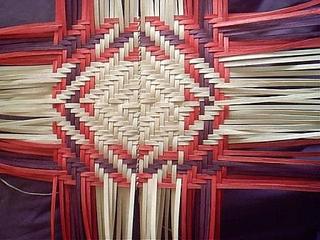
This is one of the first bottoms I wove for this basket. You can see the twining down the center, but I've found it hard to remove that once the basket is finished. This will however, show you what the bottom from the graph looks like in real form. This is 1/4 inch flat reed, it was difficult to work with, not as fexible as the natural cane and hard on the fingers. This is the same basic form you use for all square bottoms regardless of colors, color layout and size of the basket. There is a general Over 3, Under 3, when weaving except for designs where the weave pattern will vary.
This is the way the bottom for the design *Flowing Water* is layed out color wise. The colors for a traditional *Flowing Water* would be walnut where the red is in the photo and the bloodroot red-orange where the wine color is. *Flowing Water* however, is not a traditional name but the design is traditional. Most of the ancient designs have been lost.
Traditional Cherokee designs were nameless but certain families or clans wove certain designs. In some cases a specific basketweaver could be identified by a basket she had made or a member of her clan could be identified by a basket design.
Posted by
Cherokee Baskets
at
8:30 AM
![]()

This is the graph for the square double woven basket. It is 36 spokes by 36 spokes. The blue dots are the spokes that you go under. The straight lines in the middle of each side is where the corners turn.
Posted by
Cherokee Baskets
at
8:28 AM
![]()
Inches.................Millimeter
1/8..................3.175
1/4...................6.350
3/8....................9.525
1/2....................12.700
5/8.....................15.875
3/4.....................19.050
7/8......................22.225
1..........................25.400
1/16......................1.587
3/16......................4.762
3/32.......................2.381
9/64.......................3.572
11/64.......................4.366
13/64........................5.159
15/64.........................5.953
Most cane is sold by mm, so if you are like I was, I was lost when it came to converting inches to mm...so this I have found to be a handy chart of the most common cane sizes.
Posted by
Cherokee Baskets
at
8:26 AM
![]()

These are the two items not in the tools photo, the spoke weight and the spray bottle. Although spray bottle is pretty self explanatory, the spoke weight is probably unknown to the beginner. Another way of holding the spokes in place is with twining, but what I've found in the double weave is that the sinew twining is hard to remove after the basket is finished.
Posted by
Cherokee Baskets
at
8:23 AM
![]()
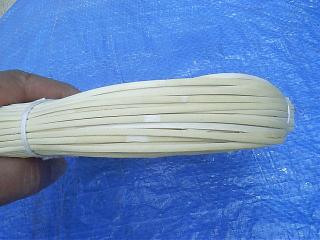
This is the Hamburg cane, as you can see it has a bleached look to it, resulting from the removal of the hard outter shell of the natural cane, so it can be dyed. They may use it for other purposes in chairs they cane, but this is the type of cane needed to dye for baskets.
When making the double woven basket you need to use the same size cane, 2.75 natural and 2.75 Hamburg for dying, otherwise the basket will not be even. Hamburg cane usually comes in 250 or 270 foot hanks, natural cane will come in 1,000 foot hanks or smaller.
I will be using the 2.75 natural and Hamburg cane for these instructions.
Posted by
Cherokee Baskets
at
8:16 AM
![]()
View of natural cane. It has a hard shiny outter shell. The natural cane will not accept the dyes so the Hamburg cane is used for dying and will make the colored designs in the baskets.
Posted by
Cherokee Baskets
at
8:13 AM
![]()
These are some of the tools I use at various times.
I keep these in a reed double woven lidded basket which I made to test the pattern for the lid. I also tie it with a ribbon, to make the lid secure since some of the objects are heavy. All of these supplies can be purchased at most basket supply shops.
Posted by
Cherokee Baskets
at
8:08 AM
![]()
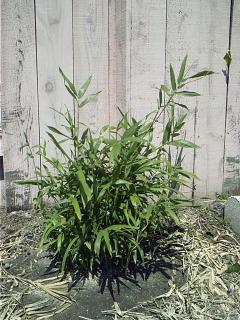
I'm posting this mainly for those who might be weaving baskets in the California area because there seems to be a type of reed which was introducted in California in the National Forrests and along the rivers which is Arundo Donax, this is a member of the reed family and was imported to the U.S. from Japan or Asia. This is refered to in California by many as river cane because it grows along the river banks here, but this is not the same cane family as the Southeastern River Cane used in Cherokee or SE Indian baskets. Arundo is used in making musical instruments such as the Oboe and the reeds for Clarinets.
River Cane of the Southeast is a member of the Arundinaria family and is a native plant to the Southeastern U.S. I have also seen this group refered to as both a bamboo and a grass. This river cane grows all the way from at least Oklahoma to Virginia, although today the quality of the cane is not the same as in earlier days. This cane grew along the fertile areas of the SE, where today it has been replaced by farming operations. Pesticide is also a growing concern when harvesting and processing natural materials.
If you have done any research of early America, many explorers refer to the thick cane brakes that they had to go through and describe using an axe or hatchet to cut a path through it, this is the River Cane they were refering to. Daniel Boone speaks of it when he went into Kentucky in the 1700s.
In California also if gathering willow in the southern part of the state, mountain lions can be a real concern.
The photo above is of my River Cane, it has to grow to about the size of your thumb to be usable for processing and weaving. The best river cane is that which is about the size of your thumb, it is usually harvested in the winter. In the SE you can also find it in some of the National Forrests and Native Americans are usually allowed to gather it from there, if for personal use.
Posted by
Cherokee Baskets
at
8:06 AM
![]()
Cherokees of the southeast used mainly rivercane, which has become increasingly hard to gather, but they also use the Palmetto to weave baskets. In Oklahoma the traditional double walled wicker made by the Cherokee after the removal, is made of honeysuckle, buckbrush or willow. These are all natural materials gathered and processed by the Cherokee prior to making the basket.
Today, for lack of many of the natural materials and because I live in California, where there just isn't any Cherokee natural materials, other than maybe Palmetto, I currently use commercial reed or chair cane. I think also these are good for learning to weave the baskets and then one can expand on other materials to use.
I am currently growing some rivercane, but that will be awhile before it will be ready to use. I also plan to plant a palmetto tree or two for use in basket weaving.
Chair cane comes in a variety of widths and will not accept the dye used for basket making. The Hamburg or bleached cane is used for the adding colored stakes for the designs. Hamburg cane has the outter hard shell of the cane removed or bleached from it, which allows for a porous cane that will accept color. So when using chair cane and if you want to add a color design, you will also need the Hamburg or bleached cane for that. Both the regular cane and Hamburg cane should be of the same size, otherwise, the baskets can come out lopsided. You can make the the baskets without color, the design just won't be as clearly visible. That is also anther way to learn the baskets and you don't have to worry about dyes.
The choice is up to the individual basket maker.
Of all the places that I have purchased cane from this is where I have found the best Hamburg cane and common cane: Bamboo & Rattan Works They have a catalogue you can download and a toll free number to order cane. Also there should be local cane shops in your area, many don't carry the Hamburg cane however, so checking around will help you locate the best source for your cane and basket supplies.
You can also use flat reed or flat oval reed, but both types are hard to weave with, not as fexible as the chair cane. Reed also makes a much bulkier basket, which I think detracts from the finished basket, especially if you're making a lidded basket. The chair cane is probably more bulky than the rivercane but less bulky than the reed. From the looks of old baskets made of rivercane, this natural material is very thin but extremely durable for making baskets, which eliminates the bulk found in other basket materials as well as giving your basket a very long life.
Posted by
Cherokee Baskets
at
8:03 AM
![]()

I will have instructions here with pictures to learn the Cherokee Baskets because I am Cherokee and know this style best...but the Choctaw also weave baskets made of rivercane and their style is similar to Cherokee...the differences usually come in the way the rim and handles on the single walled baskets are made but they also made the double woven with many of the same designs as the Cherokee.
The photo here is of a Choctaw single wall river cane basket. Notice the roll rim and the handles, this is the best way to tell that it is Choctaw. The design is *Flowing Water*.
The Choctaw also have a braided top that they sometimes use. Both methods of making the rim are very natural looking and have a natural feel when adding them to the rim of the baskets. Cherokee Baskets usually have a lashed rim, in the old Cherokee Baskets these rims were usually lashed with a smaller piece of the river cane.
Posted by
Cherokee Baskets
at
8:02 AM
![]()
I am an enrolled citizen of the Cherokee Nation in Oklahoma. My grandfather was a minor on the Dawes Rolls. I have been fascinated by Indian baskets since I was young. It wasn't until recently I learned how to weave these beautiful baskets.
My Family:
My family information is included in the Cherokee Heritage Center for their First Families, under Nancy Ward and Kingfisher. Katy, the daughter of Kingfisher and Nancy, married Ellis Harlan. Their son Ezekiel Harlan I believe died in the old Cherokee Nation in the East after 1817 but before 1838.
Craig County, OK was named after Granville Craig, the brother of my 2nd great grandmother, Louisa Jane Craig m Huff D. Coats. She was the daughter of Eliza Harlan and Samuel Craig, Eliza being the daughter of the above Ezekiel Harlan.
I weave two types of baskets, the double wall of Oklahoma and the double woven baskets of the Southeast. I live in CA so river cane is not available here and as such my baskets currently are made of Hamburg/Bleached cane, so they are classified as contemporary Cherokee Baskets.
My very favorite of these two are the old Southeastern Cherokee Double woven baskets. I believe the cane is thicker than the river cane, so the baskets are a bit bulkier than if using river cane.
I am growing river cane however and hope in the near future to process and weave baskets from the original material of River Cane used by the Cherokee in the Southeast. Commercial cane however, is also an excellent material for leaning to weave the baskets or for weaving these baskets if River Cane is not available to you.
The double wall baskets of Oklahoma are usually made of Buck brush, honey suckle or willow. Once again not having access to these materials I use commercial reed. Reed is likewise a very good material for learning how to weave these baskets or for weaving these if you do not have access to the natural materials.
The processing of the natural materials can be quite time consuming when first learning to weave. So use of the commercial material is probably better for learning.
However, remember a basket made with any commercial materials is considered a Contemporary basket even though it may be woven in a traditional style. A tradition basket is one woven using all natural materials. These instructions are for a Contemporary Cherokee Basket with a traditional weave.
Posted by
Cherokee Baskets
at
7:59 AM
![]()
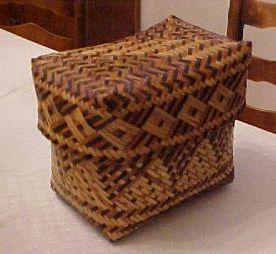
Making a double woven Cherokee basket made of common chair cane.
Double woven Cherokee baskets are not for the faint of heart! These can be difficult to learn and only mastered over time.
The Cherokee Basket photo is of a rectangular lidded double woven basket done by Eva Wolfe, made of river cane and natural dyes. She is best known for her double woven baskets she made in the 1900s. They are indeed works of art.
Posted by
Cherokee Baskets
at
7:35 AM
![]()
